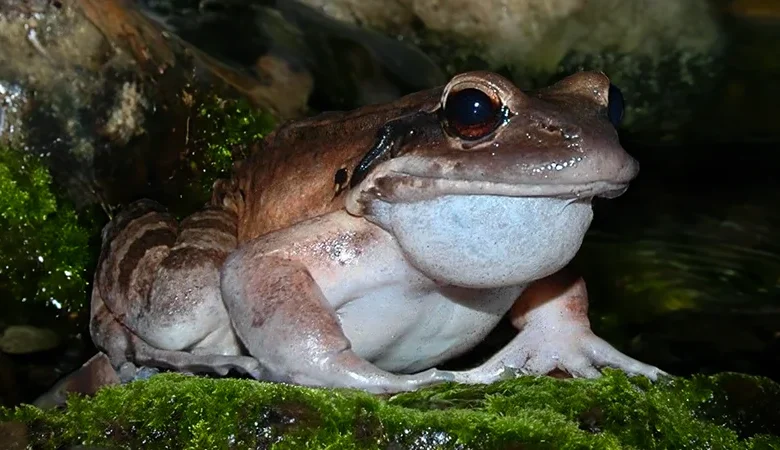Mountain Chicken

The Mountain Chicken, also locally known as the Crapaud, is one of the world’s largest frogs, native to Dominica and Montserrat. Known scientifically as Leptodactylus fallax, this critically endangered species has cultural, ecological, and symbolic importance, particularly in Dominica, where it has historically served as a food source and an emblem of national heritage.
Mountain Chicken Physical Description
The Mountain Chicken is a striking amphibian, with adult females reaching up to 21 centimeters in length and males being slightly smaller. Its skin is often brown or orange-brown, speckled with dark spots and patches that help it blend into the leaf litter of Dominica’s montane forests. The frog has a robust, muscular body adapted for jumping, with powerful hind limbs and a somewhat blunt, rounded snout. Its toes are only partially webbed, which is unusual among amphibians but advantageous for its terrestrial lifestyle. The Mountain Chicken’s impressive size and physical adaptations reflect its role as one of the top predators in its habitat, where it preys on various small animals, including insects, other frogs, and even small mammals.
Breeding and Reproduction
The Mountain Chicken’s breeding behaviour is as unique as its physical characteristics. Breeding occurs during the rainy season, from May to November, when the frog’s natural habitat becomes humid and supportive of its reproductive needs. Female Mountain Chickens dig burrows where they lay their eggs, creating foam nests that provide a moist, protective environment for the developing tadpoles. This species exhibits parental care, an uncommon trait in amphibians, with females producing unfertilized eggs as a food source for their tadpoles. This fascinating behaviour increases the survival rates of offspring, setting the Mountain Chicken apart from many other frog species.
Cultural Significance and National Symbolism
The Mountain Chicken is deep-rooted in Dominica’s cultural heritage, where it was once a staple in local cuisine. Its meat, said to taste like chicken, contributed to the frog’s common name and high status as a delicacy. Due to its cultural impact, the Mountain Chicken is featured on Dominica’s Coat of Arms, symbolizing the nation’s rich natural heritage and unique biodiversity. Although hunting the Mountain Chicken is now restricted to protect its dwindling population, its legacy as part of Dominican life endures.
Conservation Status and Efforts
The Mountain Chicken is currently classified as “Critically Endangered” by the International Union for Conservation of Nature (IUCN), primarily due to the devastation caused by the chytrid fungus (Batrachochytrium dendrobatidis). This disease, which affects the skin of amphibians, has nearly wiped out populations on Dominica and Montserrat, reducing the species by over 80% within just a few years. The chytrid fungus is considered one of the most significant threats to amphibian biodiversity worldwide, and the Mountain Chicken has been among its most severely impacted victims.
In response to this crisis, the Mountain Chicken Recovery Programme was established. This program works alongside local governments and conservation organizations to implement captive breeding and disease management initiatives aimed at preserving the species. Captive breeding programs in Dominica and Montserrat have successfully raised and reintroduced individuals into controlled habitats, though the challenges posed by the chytrid fungus remain substantial. Efforts to find a cure or treatment for the disease continue, with scientists exploring various approaches to ensure the survival of this iconic species.
Habitat and Ecological Role
The Mountain Chicken is predominantly found in Dominica’s moist, forested environments, including the dense undergrowth of Morne Trois Pitons National Park. It is nocturnal, emerging at night to hunt for food. As a top predator, it plays a crucial role in maintaining the ecological balance of its habitat by controlling insect and small vertebrate populations. This ecological function highlights the importance of preserving its habitat, which supports not only the Mountain Chicken but also a host of other unique and endemic species that contribute to the island’s biodiversity.
Challenges and Future Outlook
Despite intensive conservation efforts, the Mountain Chicken continues to face significant threats. Habitat loss due to deforestation and land development, as well as the ongoing effects of climate change, further endanger its already vulnerable population. The spread of the chytrid fungus remains a persistent challenge, with no definitive treatment for wild populations available. However, Dominica’s commitment to conservation and the efforts of local and international organizations offer hope for the species. Education and public awareness campaigns have also been implemented to increase community involvement in conservation efforts, with the aim of ensuring a future where the Mountain Chicken can once again thrive in its natural habitat.
The future of the Mountain Chicken will depend on sustained conservation measures, habitat protection, and the continued engagement of the Dominican community. The Mountain Chicken stands not only as a symbol of Dominica’s rich natural environment but also as a reminder of the island’s dedication to preserving its unique biodiversity.




